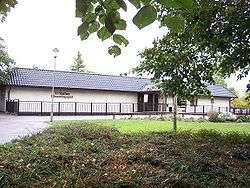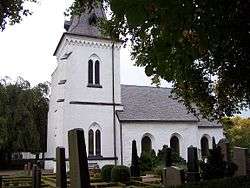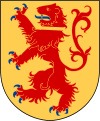Staffanstorp
| Staffanstorp | ||
|---|---|---|
|
Staffanstorps gästgivaregård in March 2012 | ||
| ||
 Staffanstorp  Staffanstorp | ||
| Coordinates: 55°38′N 13°12′E / 55.633°N 13.200°ECoordinates: 55°38′N 13°12′E / 55.633°N 13.200°E | ||
| Country | Sweden | |
| Province | Skåne | |
| County | Skåne County | |
| Municipality | Staffanstorp Municipality | |
| Area[1] | ||
| • Total | 6.63 km2 (2.56 sq mi) | |
| Population (31 December 2010)[1] | ||
| • Total | 14,808 | |
| • Density | 2,235/km2 (5,790/sq mi) | |
| Time zone | CET (UTC+1) | |
| • Summer (DST) | CEST (UTC+2) | |
Staffanstorp is a locality and the seat of Staffanstorp Municipality, Skåne County, Sweden with 14,808 inhabitants in 2010.[1] Staffanstorp is the largest Scanian settlement never to acquire town privileges before 1971, when they were abolished in Sweden.
History



The town is situated at the center of a large triangular fertile plain, reaching approximately 25 kilometres from the Øresund strait inwards in Scania. The base of the triangle follows the coast, approximately 25 kilometres starting in Malmö in the south. As a village it is mentioned in 14th century sources, but it would remain fairly insignificant in the shadow of more important towns such as Lund, Dalby and Malmö. An inn and the local hundred-jail with two cells were located there in the 19th century.
Staffanstorp expanded in the late 19th century due to railways (1875 and 1892) and a sugar factory (1885), that all were abolished about 100 years later.
A second wave of expansion is marked by the construction of a suburb, chiefly for people working in the nearby cities of Lund and Malmö. The distance is approximately 15 minutes by car to the city centers. Some 35-45% of the inhabitants commute to work outside of the municipality. Starting in 1945 with a housing cooperative building three 3-storey buildings, Staffanstorp evolved from a village with a few industries and the local center in an agrarian district, to a suburb dominated by single-family detached homes. An area of rental apartments, Åkershus, is located in the north of Staffanstorp. The apartments are owned by Staffanstorps Hus and consists of 450 apartments, divided into 25 three storey houses, built between 1970 and 1973.
The population in 1952 was just slightly above 1.000. Between 1960 and 1975, the population tripled.
In 1973 a ten years discussion ended over proposals to expand the cities of Lund and Malmö, dissecting the center of Staffanstorp. The town avoided being split in halves and remained the center of a municipality of its own.
Staffanstorp has been the site for Housing Trade Shows, the first in 1970 with 43 furnished homes and 100.000 paying visitors, and the most recent in 1997,[2] with 25 exhibited homes. In the 1990s the town center was recreated with inspiration from New Urbanism. The unpopular buildings from the 1960s were literally covered by new roofs, façades and more stories built in a traditional Scanian pastiche architectural style, a couple of multi-storey buildings were added on a lot that had previously been the local stadium, and the road plan was further complicated in order to make drivers slow down and if possible avoid going through the center at all. The recreation has been well received by architects and inhabitants alike, all objectives have however not been met: The evaluation[3] shows that availability of public transport has increased although not to such a degree that it has influenced the need and use for family cars. According to the evaluation, the inhabitants do also not feel secure when walking in the recreated town center, to which growing vegetation and too speedy traffic contributes.
Schools
Staffanstorp used to have two högstadieskola schools (senior level of compulsory school), Centralskolan and Hagalidskolan. Centralskolan was located in the central part of Staffanstorp. It had approximately 500 pupils in 2005, but now the amount is about 250 due to fewer born children. In 2013 Centralskolan changed name to Baldersskolan and began housing students between the ages 6 to 15.
References
| Wikimedia Commons has media related to Staffanstorp. |
- Lärn-Nilsson & Larsson (2002), Staffanstorps Kommun 50 år, ISBN 91-631-2686-9 (Swedish)
- 1 2 3 "Tätorternas landareal, folkmängd och invånare per km2 2005 och 2010" (in Swedish). Statistics Sweden. 14 December 2011. Archived from the original on 10 January 2012. Retrieved 10 January 2012.
- ↑ http://www.scandinaviandesign.com/bo97/bertil/index.htm
- ↑ The evaluation of downtown Staffanstorp (in Swedish) was made by David Anell for his Bachelor's degree at Växjö University

